SEO For New Websites | How To Improve Your New Site's Rankings in 2022
According to siteefy, 252+ thousand sites are launched every day.
An impressive amount, isn’t it? If you’ve recently created a new website, then you will definitely have to work hard to promote it and take a leading position in Google’s TOP 10. Knowing how to promote a new website and drive traffic to it is critical to your success.
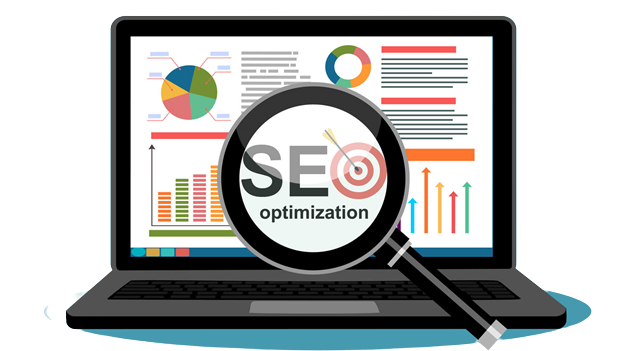
This article is for those who want to get higher search rankings. We will talk about SEO for a new site in 2022, and how to avoid the most common mistakes.
Let’s take a look at the following:
– Is it possible to do SEO for a new website on your own?
– Tips for Promoting a New Website.
– Website optimization from scratch: technical SEO audit?
– Off-page SEO. Where and how to start?
– How to build backlinks naturally and how not to harm your site?
– How many backlinks does a new site need?
– Conclusion:
Is it possible to do SEO on your own?
The cost of SEO services varies depending on factors such as location, needs, etc., but it is an investment nonetheless. Many website owners are wondering, “Can I do SEO on my own? “.
The answer is yes – you can do SEO yourself, but it will take time and effort. You’ve got to consider whether it’s really worth taking the time to learn and implement SEO on your own, or if it would be better to hire a professional SEO agency so you can focus on other aspects of your business.
Learning SEO takes time, especially if you are new to the field. Even experienced SEOs have to invest a lot of time and effort into every project.
However, if you have the time and desire, anyone can learn how to use search engine optimization to improve the website performance.
SEO itself isn’t difficult, but if you’re starting from scratch, it can take time to learn, understand, and implement best practices. If you have never worked on a website before, you run the risk of ruining your site by trying to optimize it.
After all, it is possible to do SEO yourself. Just remember to be patient and consistent.
Top 6 Tips for Promoting a New Website:
- Don’t overuse keywords.
Now search engines have learned to determine the topic even without keywords. This doesn’t mean you don’t need keywords at all, just try not to exaggerate and use them when they mostly fit the context.
- Don’t create too many pages from the beginning.
Don’t fill your blog with a lot of articles. It’s better to focus on their quality. Good content will rank faster, and the behavioral factors will improve.
- Do not ignore competitor analysis.
Very often the prep work gets neglected, and that’s a huge mistake. By analysing your highest ranked competitors, you can identify the best site structure, the most relevant keywords, the backlink profile dynamic, etc.
- Motivate your customers to write reviews about you on Google.
If people rank your company in the search engine directory, your site will rank faster and higher. Motivate the users to leave positive reviews by offering high-quality service, discounts, etc.
- Try to get traffic from different sources.
Try to drive traffic through various channels. For example, contextual advertising, social networks, crowd marketing, etc. It looks more natural to search engines when the traffic comes from different channels.
- Constantly work on improving behavioral factors.
Working on improving the user experience is an ongoing process. Regularly examine how people behave on your site, how they switch between pages, why they leave, etc. If you customize the site depending on the preferences of your target audience, users will spend more time, engage more actively, and search engines will reward you for this.
Website Optimization From Scratch: Technical SEO Audit?
Before you start promoting your new site, make sure it’s optimized and fully functional.
Here are the most common and easy-to-fix technical SEO issues for a new site.
– Low Text-to-HTML Ratio
– Broken Links
– Duplicate Content
– Missing Alt Tags and Broken Images
– Problems in Title Tags
– Messy URLs
– Problems in Robots.txt
– Misconfigured NOINDEX
– Slow Site Speed
– Mobile usability issues
Now let’s take a look at each technical SEO issue we’ve mentioned and talk about the steps you need to take to fix them.
Pages with a low text-to-HTML ratio suggest that the pages don’t have enough words and too much WordPress code.
This is more of a technical question and is solved by simply increasing the number of words on the page.
It is absolutely normal for some pages of a website to have a small amount of words. For example, your contact page or image gallery page should not have many words.
Therefore, we recommend that you go ahead and look at the URLs that show this issue. If it’s things like your contact page or image gallery, then you have nothing to worry about as these pages usually don’t have many words.
If you have any pages that are technically meant to be informative to users, you should try to increase the word count to an absolute minimum of 200, preferably 350 or more.
If you have a website with hundreds of pages, one-two broken links are common and unlikely to be a problem. However, having too many broken links is a serious blow because:
– The user experience is deteriorating.
– Broken links can significantly reduce your crawl budget. When crawlers find too many broken links, they switch to other websites, and as a result, important pages on your site won’t be crawled or indexed.
– The authority of your site will also reduce.
There are various ways to identify all broken links on your site. We recommend using the Screaming Frog SEO tool. It’s completely free and allows you to identify various SEO technical issues, including broken pages.
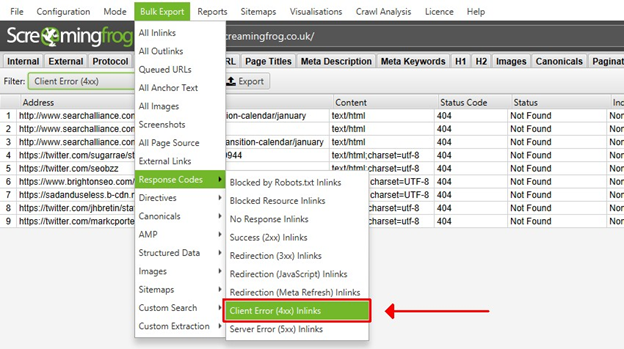
Duplicate content refers to content that is available on multiple URLs on a site. Because the same content appears on multiple pages, search engines don’t know which URL to rank higher in the search results. As a result, both URLs may rank lower.
If your duplicate content issues are really severe, you may even face penalties from Google for trying to deceive users. So if you want your site to rank high, it’s very important to make sure each page offers a decent amount of unique content.
Also, this is not just an SEO issue. Your users can be very frustrated if they flip between pages looking for something and the information just repeats. So, as with many aspects of SEO, it’s important to take care of duplicate content issues for both users and search engines.
The first step in solving a problem is identifying it. Let’s learn how to locate duplicate content.
Siteliner is a free tool that you can use to go through a certain number of pages on your site and find duplicate content.
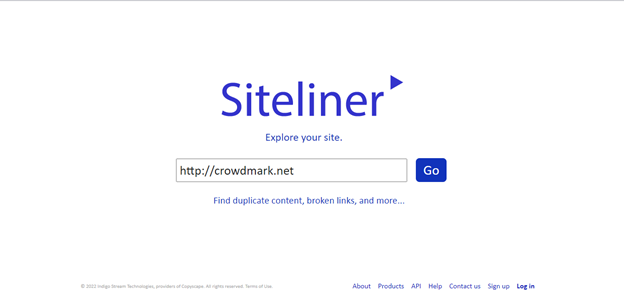
A report on various aspects of your content will show up. All of them are interesting and important, but we want to focus on duplicate content. Siteliner will tell you what percentage of content is duplicated on your site.
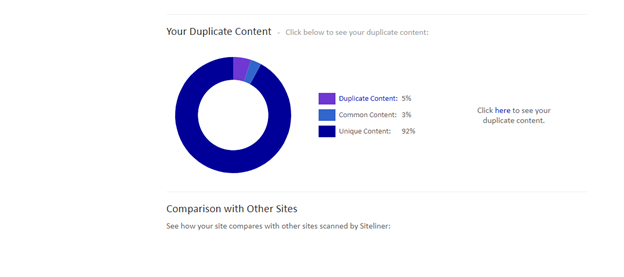
In most cases, the best way to fix duplicate content is to implement 301 redirects from non-preferred versions of URLs to preferred versions.
When URLs need to remain accessible to visitors, you cannot use a redirect, but you can use either the canonical URL or a robots noindex redirect.
You may also rewrite the content that repeats on two pages.
Choose your weapons to deal with duplicate content carefully, as they each have their pros and cons. There is no universal approach to duplicate content.
Image optimization issues are quite popular, but it is a problem you may save for later. Missing alt tags and broken images are two of the most common problems that website owners have to deal with.
Alt tags are HTML image attributes that describe the content of the image. If the image does not display properly on your website, the alt tag will describe both the content and the function. Also, alt tags help crawlers understand what your page is about.
We recommend using Screaming Frog to view your image alt text and find missing alt attributes and alt text on your website.
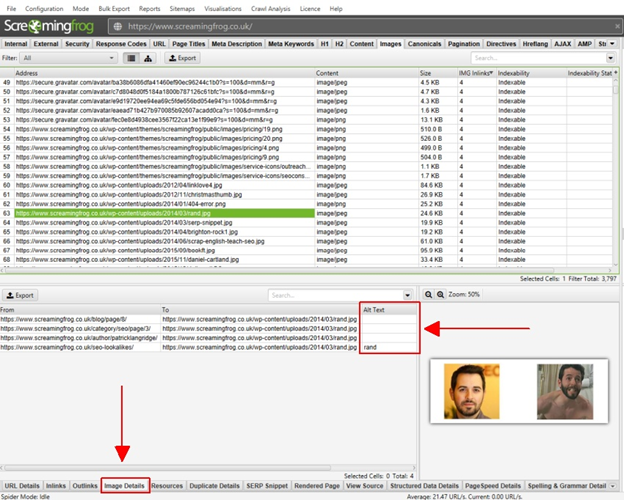
Inserting these tags is quite straightforward. All it takes is to find the image component in your HTML code and add an alt tag to it.
The source of the image looks like this:
<img src=”image.jpg” alt=”image description” title=”image hint”>
Title tags issues aren’t just very common, but also quite diverse. The most popular issues are:
Duplicate title tags
Heading tags that are too long or too short
Title tag missing
Again, you can identify title tag issues using Screaming Frog.
The title tags of your web pages should be at most 70-71 characters. We think that it is optimal to use 50-60 characters title tags.
When in doubt, follow this format:
Primary Keyword – Secondary Keyword | brand name
Give a unique title tag for each page.
URLs that look like “..index.php?p=342954” mean nothing to users and crawlers. They aren’t intuitive or user-friendly.
This is a problem that can be easily fixed. Just make sure you:
– Add keywords to URLs
– Use hyphens to separate words instead of spaces.
– Use lowercase letters
– Canonize multiple URLs serving the same content.
– Use one domain and subdomain
– Try to compress long URLs (more than 100 characters) to less than 70 characters.
Search engine bots (like Googlebot) read the robots.txt file before crawling your site to see which pages they should work on.
Spiders read this text file to determine if they are allowed to index URLs on your site. So robots.txt acts as a crawl manager.
By telling the crawler which pages to crawl and which to skip, you can better control your site’s crawl budget by directing crawlers to the most important resources.
We recommend checking your site for a robots.txt file. Just enter «yoursite.com/robots.txt» into the Google search bar. These files look a little different for everyone, but you should watch out for Disallow :/
If you see this, report it to your web developer so he can fix the issue. The Disallow line means that you are telling the crawlers not to index your site. Keep in mind that making changes to the robots.txt file can lead to serious consequences for your site, so if you’re unfamiliar with the process, entrust this task to an experienced developer.
Misconfigured NOINDEX is one of the most common SEO issues that website owners face. In fact, this SEO problem is even worse than a misconfigured robot.txt file.
A misconfigured robots.txt file will not remove your site’s pages from the Google index, but the NOINDEX directive can remove each indexed page from the Google index. NOINDEX is useful when developing the websites because the directive prevents them from appearing prematurely in user search results. But for established websites, this brings nothing but trouble.
First, you have to find the pages that have NOINDEX directive. You can use Screaming Frog or do a manual check.
Look through each of the codes and if you find NOINDEX, change it to INDEX. You can also leave this field blank. After you complete this step, Google will automatically receive a signal to resume indexing your web pages.
Slow websites have low conversion rates.
About 47% of consumers expect websites to load in at most two seconds. Also, 40% of users will leave a page that takes three seconds or more to load.
If your site takes more than three seconds to load, you’re losing nearly half of your visitors before they even reach your site.
In addition, Google takes page’s speed into account when ranking sites, so load times also affect your rankings.
Slow sites have low conversion rates.
About 47% of consumers expect websites to load in two seconds or less. And 40% of users will leave a page that takes three seconds or more to load.
If your site takes more than three seconds to load, you’re losing nearly half of your visitors before they even reach your site.
In addition, Google takes speed into account when ranking sites, so load times also affect your rankings.
We recommend using Pagespeed to measure your website loading speed.
If the load time exceeds three seconds, we recommend taking the following actions:
- Reduce redirects.
- Minify CSS, JavaScript and HTML.
- Remove render-blocking JavaScript.
- Enable compression.
- Improve server response time.
- Optimize images.
- Use a content distribution network.
Your site must be optimized for mobile devices. It is simply impossible to promote a site without an adaptive version! More than 50% of users access the Internet through mobile phones and tablets.
If you want to rank in the top 10 of Google, you just need a site that can dynamically adapt to different display formats.
You can find a large number of services that check sites for mobile usability. The most popular is the free Google service.
Off-page SEO. Where and how to start
After making sure your site is user-friendly and has no technical issues, we can move on to the next step: off-site SEO (link building).
Link building is one of the most complex parts of SEO as it requires a lot of time, effort, energy and money.
In essence, link building is an unfair way to show search engines that the site is popular, users like it and refer to it.
Search engines, on the other hand, are trying to identify resources that use dishonest SEO techniques, and if a site gets backlinks unnaturally, Google can apply sanctions to it – downgrade or completely exclude the resource from search results.
How to build backlinks naturally? How not to harm your site?
To create a safe backlink profile, you need to follow certain rules:
- The link is surrounded by text and is placed naturally;
Usually, backlinks are a way to expand information or confirm it with an authoritative source. Less trustworthy is a URL that is placed on the page as a separate element without text or is part of the interface.
- Relevance of near-link text;
The section of the article or post that includes the URL should be relevant and close to the topic of the landing page to which the backlink leads.
- A mix of article backlinks and crowd links;
It is a good sign if the URL is quoted not only in articles, but also in social media posts, forums, and other sites where most users share their experiences.
Don’t underestimate the importance of crowd marketing. Crowd links are some of the safest and most natural backlinks out there. They allow you to dilute the backlink profile and reduce the risk of penalties.
Besides, quality forum backlinks will help you get link juice and domain authority.
- Links are posted on quality resources;
Search engines evaluate the quality and the trustworthiness of the donor sites. You definitely don’t want to get backlinks from spam platforms created specifically for external optimization and advertising.
The weight of the backlink and its benefits for your site depends on various factors. Mostly, you should pay attention to the traffic of the resource, the domain’s age, the outgoing links, Ahrefs Domain Rating, Moz Domain Authority and Spam Score.
Read more on how to analyze a donor’s quality here.
- The backlink profile dynamic should be smooth, consistent, and without sudden jumps;
The link-building dynamic depends on the size of the site and the niche. An online store or a news portal may choose a more aggressive strategy than a B2B site with a narrow topic. We would recommend analysing your highest-ranked competitors. Take, for analysis, resources that are two-three years old.
- Keep a balance of anchor and non-anchor backlinks;
A natural backlink profile contains both anchor and non-anchor links. To make the backlinks look organic, you need to carefully use anchors that match the search query. Also, don’t use a specific anchor more than twice. It is better to use anchor links in a smaller proportion than non-anchor ones. (20/80 seems to be an optimal report, but again, you should conduct a competitor analysis and borrow the strategies of your highest ranked competitors.)
- If you want to get more backlinks from a specific URL, make sure the backlinks lead to different pages of your website;
In an article, the text is the most important, and links only supplement it. There shouldn’t be too many backlinks. The article looks natural when it includes one or several URLs. If the backlinks lead to the same site, the landing pages should be different.
- Keep a balance of do-follow and no-follow backlinks;
The most controversial question in SEO is: “Does a site need no-follow links?” It seemed to be an eternal controversy. But on September 10, 2019, Google decided to put an end to this dispute and officially announced that they will consider the no-follow attribute as a hint for ranking purposes. This means that they may consider the link as a credit, consider it as part of a spam analysis, or for other ranking purposes.
However, the usefulness of no-follow backlinks doesn’t end there.
How do they help, and why do you need them?
Such links will perfectly dilute the backlink profile of your site, making it natural and organic. In addition, no-follow backlinks can bring you quality leads. A good post on Quora, Reddit, or a large thematic forum can bring you thousands of clicks.
Learn more about the usefulness of no-follow backlinks here:
- Users click on the backlinks;
If the information is useful and interesting to readers, they are more likely to click on the links and come to your site. The backlinks will be more effective if users follow them.
How many backlinks does a new site need?
Many believe that the more backlinks at the start, the better. In fact, this is a complete misconception.
After all, even a few high-quality crowd links can bring a much greater effect. Therefore, when determining the reference mass, focus on your competitors.
First, determine the keyword you plan to rank for. Check your keyword search frequency and keyword difficulty with SEO tools like Ahrefs.
Conduct competitor analysis (select sites no older than three years) – how many backlinks they have, how their link profile has grown, what anchors they use, etc.
For example, you can take three sites with high rankings and no more than two years old. Using Ahrefs or any other SEO tool, determine the average number of backlinks they receive monthly and how their backlink profile has evolved.
It’s important not to overdo it. So, during the first month, you can get several links, constantly increasing the dynamic.
For example, if you started with 40 links, then in the next month you can double them. Thus, link building will occur gradually, organically, and consistently.
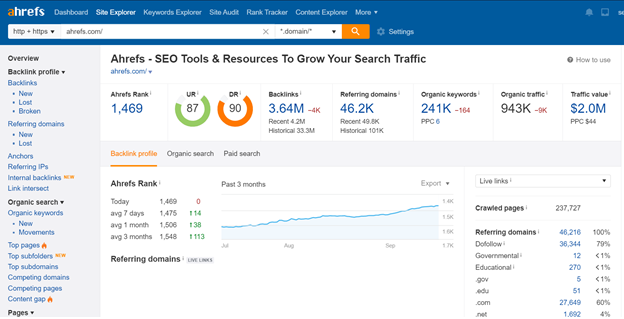
Conclusion:
In conclusion, I’d like to emphasize that when promoting a new website, it is important to focus on quality content, simple and clear structure, usability, and quality link building.
Sometimes it can be even easier to promote a new site as it was never penalized, has no negative reputation, has no low-quality backlinks, etc.
The only difficulty is that users don’t know about you, while search engines don’t have enough data to rank your website high.
This can be fixed by attracting quality traffic. For example, you can promote your site on Q&A platforms, launch contextual advertising, apply social media marketing, etc. We at crowdmark.net can help you drive quality traffic and boost search rankings through our forum link building and Quora marketing services.
The more interested users come to your site, the faster search engines will notice, and rank it higher. Therefore, there is no need to sit and wait a year until the site gets out of the “sandbox”.
All the factors that we’ve talked about above can help you speed up the promotion process, so start your search rank elevation now!
CrowdMark provides strategic, creative, and performance services to consumer-oriented businesses. We help companies increase brand awareness, raise sales, create community, drive interaction and improve site rankings through innovative SEO techniques.